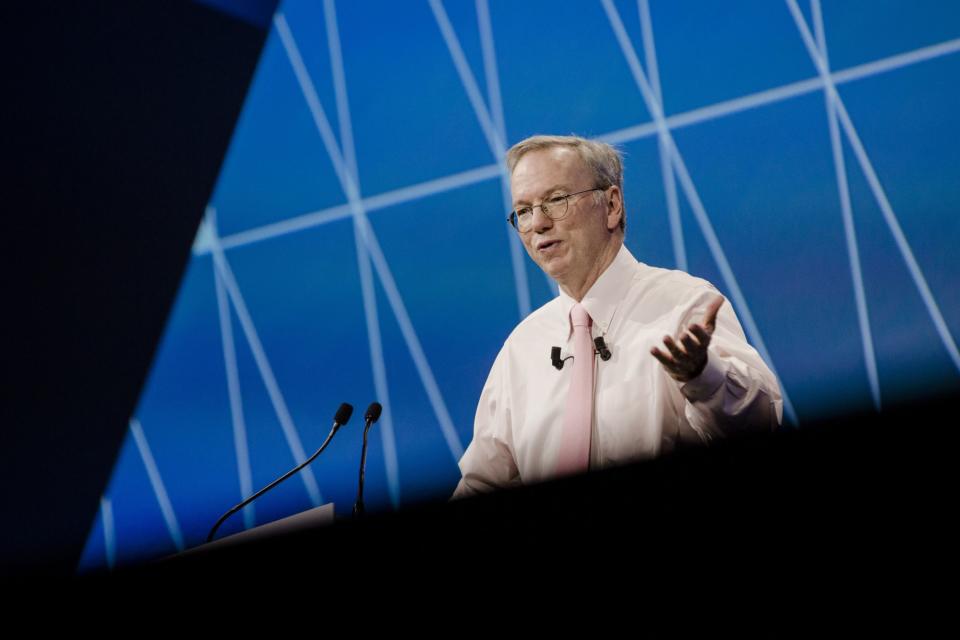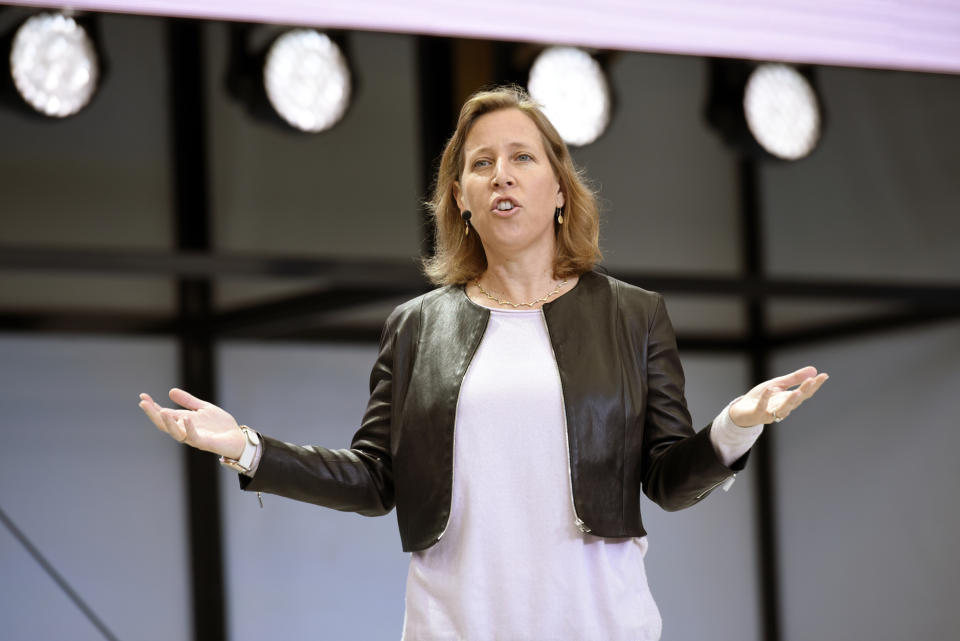YouTube's Trampled Foes Plot Antitrust Revenge
(Bloomberg) -- Brian O’Kelley built AppNexus Inc. to help companies advertise anywhere on the internet. Its software plugged into virtually every digital ad-trading hub, including those from Google, the biggest ad seller, and Google’s YouTube video service. By 2014, AppNexus was valued at $1.2 billion.
Then, in 2015, Google stopped letting companies buy ads on YouTube using outside software. The move got more marketers to use Google ad services. It also created a glaring hole for AppNexus: The startup could no longer give customers access to the largest supply of online video. It never really recovered.
“They crushed our growth and ruined our product," said O’Kelley, who stepped down as AppNexus chief executive officer last year. YouTube represented a huge portion of the video inventory that AppNexus offered to advertisers. Those marketers couldn’t just ignore YouTube "because it’s pretty much a monopoly in that space," he added. "It’s not a supply-and-demand problem. It’s a ‘You just broke our entire business’ problem.’”
The story is familiar to advertising and media entrepreneurs who built businesses around YouTube, only to be hobbled when the video giant changed the rules of engagement. Google used YouTube’s popularity to lure creators, media companies and tech firms onto the service, gaining access to more videos and ad space. YouTube then used that supply to control ad prices and amass data about viewers, squeezing out anyone that tried to compete, according to interviews with more than a dozen partners, rivals and former employees. Many asked not to be identified discussing sensitive information about a powerful industry player.
YouTube didn’t wipe out competition in one fell swoop, or act maliciously, according to these people. Instead, YouTube made decisions to consolidate the video ad-buying process, with little regard for partners or competition, and few regulatory checks. That left a graveyard of failed companies in its wake and fewer choices for advertisers, the people said.
In digital video advertising, YouTube has no peers. The U.S. market harnessed $16.3 billion in ad spending last year, according to the Interactive Advertising Bureau. YouTube accounted for the majority of that. Globally, the video giant generated $16 billion in 2018 sales, BMO Capital Markets estimates.
YouTube disputes this depiction of its dominance. The company said it shares more than half its ad sales with video producers, and competes in a much bigger market than just online video ads. "Viewers have never had more choice when it comes to where to watch their favorite videos," YouTube spokeswoman Andrea Faville wrote in an email. "Similarly, advertisers have a wide and growing array of options, including traditional television, which still accounts for the majority of video ad spend."
But U.S. regulators and politicians are now listening to claims that Google and YouTube may have run afoul of the law. The Department of Justice is considering an antitrust investigation of Google. The Federal Trade Commission is probing allegations that YouTube violated privacy laws protecting children, Bloomberg reported earlier this year. Congress, which has multiple investigations into Google and its peers, recently requested an interview with a former YouTube business partner, according to some of the people who spoke with Bloomberg.
“If you’re looking into Google, it would be remiss not to look at YouTube,” said Sally Hubbard, director of enforcement strategy for Open Markets Institute, a think tank. “You’ve got monopolies upon monopolies.”
YouTube may be preparing for scrutiny. Its executives recently reached out to partners to ask how its practices have affected their ad sales, according to one of the people who spoke with Bloomberg. YouTube did so as part of typical partner relationship management efforts, but this person interpreted the outreach as a sign of YouTube nerves about antitrust regulation.
Vevo humbled
Few companies show YouTube’s grip on the digital video market better than Vevo, which distributes music videos online from two of the three largest record labels.
The company was conceived by Doug Morris, then head of Universal Music Group. Founded in 2009, Vevo collected music videos and original programming, and distributed those clips across the internet – on YouTube, on Yahoo and on Vevo.com. The ultimate goal was to turn Vevo’s site into the MTV of the internet and get higher advertising rates, Morris said.
At a lunch with Morris, then Google CEO Eric Schmidt embraced the idea. Vevo could share ad revenue with the internet giant when Vevo clips ran on YouTube.
As YouTube grew, though, the relationship frayed. Vevo music videos were popular on YouTube, and advertisers loved them. But YouTube couldn’t sell ads on these clips because Vevo had exclusive rights in every market where it operated. The Google unit set out to take control of this valuable inventory through aggressive contract negotiations, sneaky sales tactics and even an effort to buy its rival outright, according to the people who spoke with Bloomberg.
In late 2012, YouTube proposed a new contract that would have allowed it to also sell ads on Vevo videos, and would have reduced Vevo’s share of the revenue from those ads. Google also offered to buy Vevo. When the record labels balked, YouTube said it would take down Vevo music videos before the existing contract expired, according to the people who spoke with Bloomberg.
Vevo’s leadership called an emergency board meeting. The company stood to lose millions of dollars if it disappeared from YouTube, which then reached about 1 billion people a month and accounted for most of Vevo’s audience and sales.
Vevo executives told YouTube they would file an injunction describing what they said was bullying tactics, and asking a judge to block the video giant from removing Vevo videos, according to former employees and music industry executives. The gambit worked. YouTube agreed to a new deal that let Vevo keep exclusive rights to its ad inventory.
In July 2013, Google acquired a minority stake in Vevo. That didn’t give it full control, but offered more visibility into Vevo’s business.
YouTube’s attempts to stifle Vevo continued, according to people familiar with the efforts. While it couldn’t access Vevo’s ad inventory, the video giant could reduce its influence, the people said.
YouTube encouraged artists to go around Vevo by creating their own YouTube channels to replace the ones operated by Vevo, the people said. Faville, the YouTube spokeswoman, said the company encouraged artists to consolidate their presence on a single "official" channel to avoid confusion. "This product change was a net benefit to fans and artists," she added.
YouTube also flirted with the limits of its Vevo deal. Some of YouTube’s sales pitches to advertisers included the Vevo logo and artists such as Rihanna, according to people who saw the documents. The documents suggested that YouTube could run ads on Vevo videos even though YouTube was contractually prohibited from doing so. Vevo executives flagged the problem to YouTube executives, who apologized and blamed the sales team, the people said. Faville called this a one-time error.
Vevo tried to send viewers to its own website and mobile app, but YouTube’s algorithms made that risky. The software recommended videos that were watched a lot on YouTube. If Vevo clips were seen elsewhere, those views were not counted by the Google unit. The result: Vevo videos didn’t perform as well on YouTube, according to industry executives. Faville said YouTube’s algorithms don’t factor whether videos direct viewers elsewhere.
In 2018, Vevo stopped competing with YouTube for a large consumer audience, shutting its app and website, and cutting product and engineering staff. Around the same time, YouTube secured a deal that gave it what rivals say it wanted all along: the right to sell Vevo’s ads.
In thinking about what went wrong, Morris remembers discussing Vevo with Steve Jobs. “Why won’t Vevo be worth billions?” he asked before the Apple Inc. co-founder died in 2011. Jobs said Google already effectively owned Vevo because YouTube had a lock on Vevo’s viewers. "They’ll control it," Jobs warned, according to Morris.
Once envisioned as a site that would compete with YouTube for views and ad dollars, Vevo is now mostly a logo with a small sales team.
Machinima’s demise
Machinima Inc., like Vevo, started out as an asset for YouTube. In YouTube’s early days, it didn’t have an advertising sales team nor staff managing relationships with individual video creators. Machinima was one of the first companies to assemble a network of YouTube channels and creators. It sold ads on the channels’ behalf, struck deals with brands and developed YouTube stars, including PewDiePie, one of the most popular video bloggers. That success spawned clones, including Maker Studios, Fullscreen and AwesomenessTV. Known as multi-channel networks, or MCNs, they were seen as the cable networks of the future.
But the relationship soured as MCNs got big enough to compete for ad dollars. YouTube executives didn’t want third parties getting in between viewers, video creators and advertisers, according to former MCN executives and employees. So YouTube made MCNs superfluous by replicating many of their offerings, while limiting their access to data and tools that would have helped them build their own businesses, these people said.
In November 2013, YouTube instituted a policy that made it clear MCNs would need to look beyond YouTube if they wanted to thrive. The company said it would take 45% of ad sales from all partners on YouTube, up from the 30% it collected from some large media companies. Solo creators could survive on a 55% share, but the MCNs couldn’t support their growing staff and expansion plans.
“These companies realized advertising sales weren’t enough,” said Peter Csathy, founder of advisory firm CREATV Media. “Too much of a share had to go to YouTube.” YouTube’s Faville said revenue sharing agreements with MCNs didn’t change.
The MCNs tried using collective power to get more favorable terms. They wrote a letter asking YouTube to consider changes, but that went nowhere. Some MCN executives pitched their boards on going to the Justice Department to file an antitrust suit against YouTube, but directors refused to fund what would have been a long and expensive legal battle, according to people familiar with the deliberations.
Relations between MCNs and YouTube deteriorated under Susan Wojcicki, who took over as chief executive officer of YouTube in 2014. The veteran Google advertising leader corralled the company’s huge digital sales force to focus more on YouTube. She also created Google Preferred, a package of the best-performing videos on YouTube that advertisers could buy.
YouTube already sold more video ad space at attractive prices than any media company online. With Google Preferred, YouTube could also compete on quality. Google offered advertisers similar videos as Machinima at lower prices, with better targeting and more volume. YouTube had the relevant clips – and, with data from Google’s other popular services, it knew more about what viewers wanted to see. Smaller media companies like Machinima could not sustain their sales forces selling less-targeted ads at the lower rates offered by Google and YouTube.
One by one, the MCNs either shrank, sold themselves or died. Earlier this year, Machinima laid off its remaining employees and ceased operations.
AppNexus’s ordeal
Brian O’Kelley’s AppNexus had a similar experience. It flourished in a market that Google helped create: programmatic online advertising. For years, ads were placed with handshake deals between marketers willing to spend and websites willing to sell. With programmatic software, buying ads became more automated, effective, cheaper and faster. Several firms raised millions of dollars to pursue this opportunity. Rocket Fuel Inc., went public in 2013 valued at more than $2 billion. The Rubicon Project Inc. did an initial public offering in 2014, and AppNexus was tipped to follow.
But in 2015, Google made a move that showed how powerful it was in this market. Google removed YouTube inventory from ad exchanges run by other companies including AppNexus. With a few exceptions, any advertiser that wanted to market on YouTube had to use Google’s software or ad exchange.
Google saw a business rationale behind the decision. Outside exchanges handled less than 5% of YouTube’s ad slots at the time, according to the company. Also, YouTube’s most popular ad format -- a skippable one that ran before videos, called TrueView -- was "not supported" on external exchanges, YouTube’s Faville said. Keeping such a small slice of ads available to buyers through other exchanges wasn’t worth the extra work.
However, O’Kelley and others in the ad-tech industry saw the move as a clear example of Google using YouTube’s assets to favor other parts of its business -- in this case, Google’s ad software -- at the expense of rivals. Five percent of YouTube ads may not be important for Google, but it’s a vast amount for smaller competitors.
Dina Srinivasan, a former executive at ad agency WPP Plc, compared Google’s 2015 move to a company decreeing that investors can only trade popular shares on one stock exchange, and through one brokerage firm.
Google ad prices are set in an auction and not public. But taking YouTube off outside exchanges probably reduced the number of marketers bidding on its ads, lowering prices, according to Srinivasan. “Google may have absorbed a loss in YouTube revenue for some other reason,” she added. “The question regulators will be asking is whether that reason was to drive out competition.”
Despite a short-term dent in YouTube sales, the ploy likely increased the long-term value of Google by billions of dollars because it strengthened the company’s grip on advertising technology, according to O’Kelley. "That’s kind of how monopolies roll," he said.
There’s a “no economic sense” test in U.S. antitrust law that may apply here, according Srinivasan. The Justice Department’s top trustbuster Makan Delrahim discussed this in a recent speech about big tech companies. When oil refineries refused to sell themselves to Standard Oil in the late 19th century, the giant cut prices to drive them out of business. Lower prices are the essence of competition, but a powerful company is not allowed to do things that make no business sense just to make it harder for rivals to catch up, he said.
YouTube said its tactics were sensible. "Like any business, we make changes to how we operate to reflect the current climate," Faville said. "We make all these decisions with the same goal: to improve the YouTube experience for our users, creators, and advertisers."
Since Google changed the YouTube ad-buying process, much of the rest of the programmatic market has withered: Rubicon Project is trading about two-thirds below its IPO price; Rocket Fuel Inc.’s valuation fell below $100 million before it was acquired. The AppNexus IPO never happened and it sold to AT&T Inc. last year for $1.4 billion. The Trade Desk Inc. is a rare thriving player, but it operates in China and other markets where Google is less active.
In 2016, several ad tech companies, including AppNexus, met with Justice Department and Federal Trade Commission to discuss the industry, and some complained about YouTube’s behavior, according to O’Kelley. The response was tepid at best, he said.
“We had a really hard time getting them to pay attention," O’Kelley recalled. "They would say, ‘It’s hard to understand.’" A spokeswoman for the FTC declined to comment, and the Department of Justice didn’t respond to a request for comment.
But now, O’Kelley may have a more attentive audience. In May, he testified before the Senate Judiciary Committee on digital advertising. "This is not a functioning market," he said. "It enables Google, which doesn’t produce content, to monopolize all aspects of the programmatic business and take a disproportionate tax for its trouble."
Later, over the phone, O’Kelley was less grim about the political response. "Maybe now they’re paying attention," he said.
To contact the reporters on this story: Lucas Shaw in Los Angeles at lshaw31@bloomberg.net;Mark Bergen in San Francisco at mbergen10@bloomberg.net
To contact the editors responsible for this story: Jillian Ward at jward56@bloomberg.net, Alistair Barr, Emily Biuso
For more articles like this, please visit us at bloomberg.com
©2019 Bloomberg L.P.

 Yahoo Finance
Yahoo Finance 


